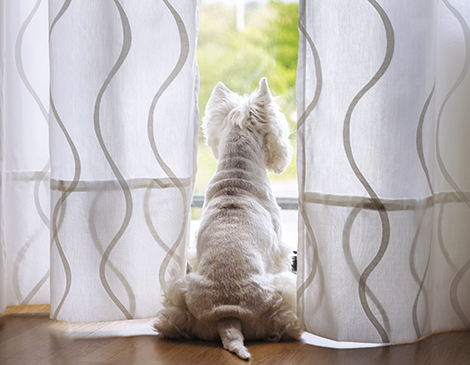We all look forward to a post-pandemic world when we can return to the office, travel and spend less time cooped up at home — but what about our pets? Veterinary behaviorist Dr. Elizabeth Feltes, owner of the Behavior Clinic in Olmsted Falls, says it’s time to start thinking about how to ease the transition for the animals we love by prepping them to be more comfortable at home without us.
“There is evidence to say that prolonged constant contact followed by abrupt departure can be significant when it comes to separation anxiety in pets,” Feltes says, “and that’s what we want to work to avoid.” Dogs are most likely to suffer from separation anxiety, though cats and birds — especially chatty parrots — can experience it, too.
She encourages pet owners to start being intentional about leaving the house, seeing each exit as an opportunity to prepare their pets for the future. Making a trip to the grocery store or going for a run? Give your furry friend a treat that will compete with your presence — something healthy that they really love. “Short departures can pay big,” Feltes says.
For dog owners, it’s also a good time to harken back to everything your pup learned in obedience school. “Creating a persistent and desirable routine with departures helps make sure they’re getting their ‘yayas’ out before we leave them alone,” she says. Before you leave home, enforce behaviors like asking dogs to sit before being leashed or to give a paw before receiving a treat, which brings down dogs’ energy levels and puts them at ease — and will hopefully persist even after you’ve left the house.
Feltes warns that pets may also exhibit distressed behavior that isn’t necessarily tied to separation anxiety. For example, once you return to the office and your dog is left alone, he may suddenly become stressed by everyday occurrences he’d previously ignored, like the mailman’s arrival or kids shouting next door — resulting in barking, soiling, destroying the furniture and other less-than-ideal reactions. “You can look at minimizing exposure [to outside stressors],” Feltes says. “Put up opaque window treatments or turn on white noise to buffer the outside noises your dog is noticing more.”
Ultimately, she says, the best way to determine what issues your pet has in your absence is to set up a video camera, like Ring, that allows you to monitor their behavior and, if necessary, explain their behavior to your veterinarian for professional input — and it’s important to start doing so before the pandemic ends. “You’re looking at trying to prevent this problem,” Feltes says. “The phrase ‘prevention is worth a pound of cure’ is absolutely true.”




